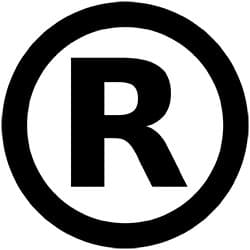Questions of trademark law often come up in video production. In this post we’ll talk about what trademarks are and provide some guidelines for using them.
What Is A Trademark?
A trademark is a way of identifying a product or service. This is usually a name, a design (such as a logo,) a slogan or phrase. However, there are unorthodox identifiers. Trademark protection has been claimed for colors, sounds (such as jingles or sound effects,) shapes, and even smells.
What can you not trademark? You cannot trademark an identifier that infringes on another company’s brand, and you cannot trademark a generic or descriptive name. A filing for Cheese Pizza™, for instance, would not be successful.
Just like copyright, filing for a trademark is not necessary in order to gain common law protection. If I wrote a novel, it would have copyright protection the minute it came out of my printer. Likewise, our company’s name IdeaRocket gained trademark protection the minute we registered the business, and the courts would offer protection against infringement of our logo as well.
What is the U.S. Patent and Trademark Office for then? An official trademark can help you make sure you’re not infringing on the trademarks of others, since an exhaustive search is made before the trademark is granted. A filling can also help broaden the geographic reach of your trademark, and reduce uncertainties in case your trademark is disputed in the future.
Fair Use Of Trademark
Just as in copyright law, there is a fair use doctrine in trademark law. However, it is far more narrow in scope. There are two kinds of trademark fair use: descriptive and nominative.
Descriptive use is when a trademarked term is used to describe a product. The example from case law is when WD-40 was able to use the word “inhibitor” even though there was an anti-corrosion product called The Inhibitor. WD-40 wasn’t seeking to confuse or mislead, they were just looking to describe what their product did.
The other sort of fair use is nominative. Here, the trademark is being used to identify the product. In the previous paragraph, I referred to WD-40, but it is unlikely that I would be found in breach of trademark because no one is going to think that IdeaRocket is selling a lubricant, or that it is being endorsed by WD-40. I am using the term to denote the company and its product. This sort of use is protected even in comparative advertising (think Coke vs. Pepsi,) although it does carry more risk in that context.
Both of these kinds of fair use demand that no more of the trademark is used than necessary. If I used the WD-40 logo on the top left of the page, where our IdeaRocket logo is, then my intentions might be put in doubt.
Client Rosters And Media Mentions
How do these issues come up in video production? The two most common questions are regarding client rosters and media mentions.
A client roster can be a great way of bringing credibility to your B2B company. The B2B buyer is notoriously risk-averse, and seeing the reputable names of your previous clients makes them feel at ease.
“It is always a good idea to get permission to use someone else’s logo, especially a client’s,” says Josh Gerben from Gerben Law. “That being said, in most situations it would not be legally necessary to obtain permission to post a client’s logo on a video so long as it is clearly being used just to identify the client as a past or present client.” However, he does note the need for some caution. “Service contracts can sometimes include confidentiality clauses which could be violated if you use a client’s logo.”
The other way other company’s trademarks are often used is in a media mention section. If you have been featured on television or a reputable media outlet, it builds trust to say so. If these sections use clear language that does not connote endorsement or affiliation, such “As Seen In,” then this sort of use will be seen as nominative.
Should you include trademark symbols in your name or logo?
How about when you are showing your own trademark? Should you include one of the well-known symbols next to your logo? First, let’s define what they are. The R in the circle is the Registered symbol. It is only allowable for use if your trademark has been registered with the US Patent and Trademark Office, or an equivalent national registry.
The TM refers to a product trademark. The SM refers to a service mark. These can be used even if your name or logo has not been registered. What is the function of these marks? Colin Fowler from Perkins Coie says they “carry no legal significance, but one might use them to dissuade others. In a sense, it is a warning. It says, ‘I will enforce my rights against you if you try to copy this.’ “
Fowler goes on to point out that these marks have a certain branding connotation too. These symbols have “a certain level of formality. If your company sells surf-boards, formality may not actually be a good idea for your brand. Whether or not a company should use TM/SM depends on what image they want to convey to the market.”
A Fundamental Principle
One of the fundamental principles of trademark law is that it exists to protect the consumer from confusion, not to protect the brand-holder.
There have been instances where companies have lost their trademark protection when their product name came to represent the product category itself, rather than a brand of the product. Says Josh Gerben: “ ’Aspirin’ used to be a protectable trademark, however, it became generic for a type of pain medication. This means that any company may now use the trademark to identify a medicine product as ‘Aspirin’. “
How can a company protect against this? Gerben says they should “always police the marketplace to ensure third parties are not using their trademark in a generic sense. For example, Xerox will typically contact anyone that talks about making ‘xeroxes’ of something. They will remind the individual that you should talk about making ‘photocopies’ instead.”
Lawyers Sometimes Disagree
Legal matters are not always cut and dried.
Some years ago we created the show-open for the 8th season of the Showtime show Weeds. Toward the end of the production, we noticed that the logo of the marker used to ‘draw’ on the illustration – Sharpie™ – was clearly apparent onscreen. We panicked. Would we need to re-shoot and re-composite entirely?
The Weeds producers passed it on to their counsel at Showtime. Their opinion was that the product was used as intended, in a non-derogatory way, so there should be no problem.
Cut ahead a couple of months. We were producing a whiteboard spot for an up-and-coming tech company. We used the same hand from the Weeds show-open, and the same issue came up. This time, the verdict was different: we would need to obscure the logo throughout. (The company’s Creative Director helpfully suggested that perhaps the Weeds lawyer was “high.”) My instinct is to trust the judgment of the Showtime lawyer, but to avoid any further problems, since then we’ve only used logo-less markers.
How To Work With Lawyers
A mistake business people sometimes make is letting their lawyer present judgments as binary: Yes, this is allowed. No, this isn’t.
The lawyers we interviewed for this article had a more business-contextual approach, and that’s what you should demand from your lawyers. Is this a high-risk, medium-risk, or low-risk situation? What would be the consequences? It’s your lawyer’s job to tell you the risks; it’s your job to decide when and whether the risks are worth it. (Lawyers tend to be a bit more risk-averse than entrepreneurs.)
Having said that, let me be risk-averse and say that the information in this post should not be a substitute for qualified legal advice. I am not a lawyer, I just play one on my blog – with the help of some actually qualified people! For more helpful content delivered to your inbox monthly, sign up for our newsletter.





